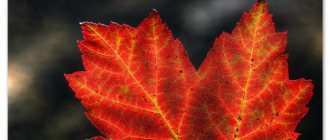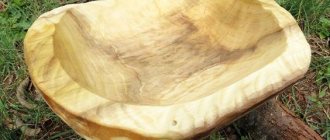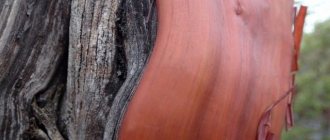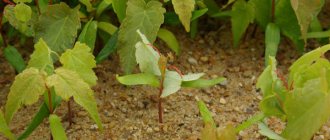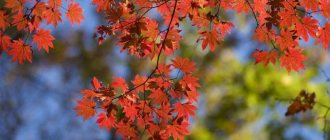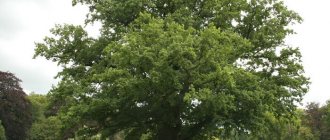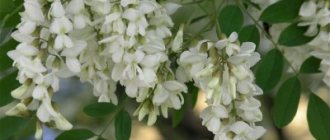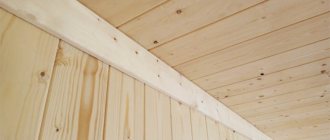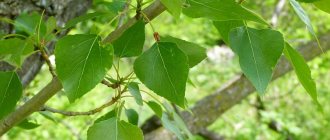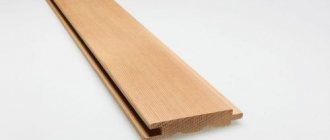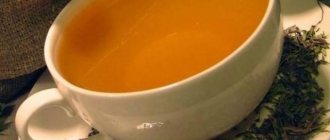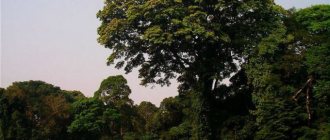- Reports
- Plants
- Maple
Maple is one of the most popular trees not only in Russia, but throughout the world. The famous maple leaf has been recognized by everyone since school years. The maple tree is especially beautiful in the fall, when the leaves turn bright colors. They can be not only yellow, but also red, orange, crimson, burgundy. Such a tree is present in every park, because such beauty should not go unnoticed.
Maple can grow up to 30 meters. It is not afraid of cold and is resistant to drought. For Russian latitudes, this is an important factor. This gives Maple a great advantage over other trees. It also grows quickly. One of the first to bloom. As soon as spring begins to come into its own and it gets really warm outside, the maple tree absorbs the right amount of moisture and you can even enjoy its delicious syrup. In this regard, it is very similar to Birch, which can also treat you with its sweet sap.
During flowering, Maple smells very strongly, which is of genuine interest to insects that collect nectar. Bees are especially lucky in this regard. Maple is a real find for them. Therefore, many experienced beekeepers always plant Maple on their plot.
Maple fruits look like little propellers, but are called lionfish. The wind blows them off the branches and when they fall to the ground, new trees begin to sprout.
Maple wood is very popular in industry. It is mainly used to make various musical instruments. They are also used to make baseball bats and bowling pins.
It's no secret that the Maple Leaf is a symbol of a country like Canada. It is depicted on the flag and looks very original. The history of the appearance of the maple leaf began back in 1860. At that time, the city of Toronto was about to welcome a guest of honor: the Prince of Wales. Many immigrants brought with them various symbols of their countries. At that time, the symbol of Canada was the beaver. Since bringing a beaver to the meeting would have looked rather stupid, it was decided to replace it with a maple leaf. Since then, the maple leaf has remained a symbol of faith, friendship and understanding for Canada.
Some maple species are very rare. For example, Japanese maple is listed in the Red Book of Russia. This is a unique tree and should be treated with due respect. Nature is very beautiful and diverse, and Maple is one of the proofs of this.
2, 3, 4 grade
general description
The described type of flora is common in the countries of the Northern Hemisphere, as well as temperate climate zones of Asia. Its name Acer is translated from Latin as sharp due to the original shape of the leaves. It is mainly a deciduous representative of the plant world, however, there are evergreen varieties. They grow and develop well in both fertile and poor soils.
Maples can be of the following forms:
- tree-like;
- shrubby.
Depending on environmental conditions, tree-like specimens grow up to 30 meters, have a lifespan of approximately 500 years, and a powerful trunk of about one meter in diameter. They have a dense crown, which provides coolness and shade on hot summer days. Young trees have smooth bark with a reddish tint; with age it becomes cracked and darkens.
Shrub varieties have a common base from which numerous branches grow in different directions. The maximum height is from 10 to 15 meters.
In most maple representatives of the flora, the leaf has a pinnate or palmate shape, the surface is covered with multiple veins branching in different directions. The petiole is long and well developed. The inflorescences are greenish-yellow in color and look like racemes, umbrellas or brushes. The flowers contain enough nectar to attract honey insects.
Maples are predominantly dioecious plants. The ripened fruits are called lionfish. They are equipped with two blades, rotate when moving through the air and are easily carried by the wind over significant distances.
About plants of Russia for children. Maple
More than 20 species of maple grow in Russia: in its European part and in the Far East.
Norway maple leaves are large, rounded-angular in shape, with large sharp protrusions along the edge. Botanists call such leaves palmate-lobed. Tree up to 30 m tall, up to 1 m in diameter, with a lush crown. The trunk is covered with gray bark with small cracks. Young shoots have reddish bark. The fruits ripen in September.
In autumn, no tree seems as beautiful and elegant as maple. Gradual cooling, especially in dry weather, colors its leaves in various warm colors - yellow, orange, red, purple. This means that the protective coloring substances of the wood - pigments - come into effect one by one. They help the maple to better adapt to changing weather conditions.
You will not see damage caused by caterpillars and beetles on maple leaves - insects do not touch its foliage.
Maple blooms in spring. Its flowers bloom at a time when the tree has not yet put on leaves; small leaves have just appeared. A blooming maple is noticeable from afar: many greenish-yellow inflorescences can be seen in the crown of the tree on bare branches. All flowers contain nectar and are readily pollinated by bees. Maple is one of the best honey plants.
The maple fruit consists of two winged fruitlets, sticking out in different directions and grown to each other. These fruits are called lionfish. Lionfish, falling even from a small height, rotate very quickly. It turns out to be a propeller that carries the fruit with a tailwind over long distances.
Maple grows well in the shade and in poor soils. Its seeds have excellent germination. That is why we so often see friendly shoots of young maples under the canopy of other trees.
Maple tree sap is sweet. Even our usual maple - Norway maple - contains up to 5% sugar. And in Canadian - 4 times more. That's why it's called sugar.
Maple is a very common tree in Russia and Europe. It is often planted in park areas, where it gets along well with oak trees. Landscape designers love maple for its fast growth and frost resistance. This makes it possible to grow these trees even in northern latitudes, where they take root well. A distinctive feature of maple is the diversity of its species and the beauty of its leaves. They delight with their patterns and colors. Autumn maple leaves are especially solemnly beautiful. Descriptions of such bouquets can often be found in literary works. Not only writers, but also schoolchildren are interested in this tree. In 6th grade biology, close attention was paid to the description of a maple leaf. Children study its structure in a special section of the textbook. In this article we will provide a description and photo of maple leaves, and also talk a little about the species diversity of this beautiful tree.
Variety of species
There are many varieties of this type of vegetation around the globe. The report about maple tells about the most popular species. Among them:
- White;
- Holly;
- Field;
- American;
- Black;
- Tatar.
The white variety has several names - false sycamore and sycamore . This slender tree-like plant grows up to 30 meters, its top is decorated with a lush crown in the shape of a tent. The leaf is dark green on one side and whitish on the other. Grows in the southern regions of Russia, Ukraine, and Europe.
Holly is the most popular species, widespread in the central zone of the Russian Federation.
The report on Norway maple provides a brief description of several of its varieties, which have different leaf colors.
For example, the Drummondi species has pink-colored young foliage that becomes creamy over time. Another unusual variety, Rod Royal, is covered with red leaves throughout the growing season.
Field varieties are classified as shrubby plants. It has small, inconspicuous inflorescences and a spherical crown. In the wild it grows on different soils and tolerates cold, short periods of drought and wind.
The American type grows in some areas of North America and is the symbol of one of the states. It produces a very sweet juice, from which the syrup of the same name is produced. It feels comfortable in cold climate zones, has a powerful trunk with dark bark and a lush spreading crown.
The black look is considered one of the most beautiful and unusual. It grows near bodies of water on the North American continent.
The leaves of this tree are dark burgundy in color, their shape can be five-fingered or three-fingered, and the sharp ends are always lowered.
Tatarian or black maple has the form of a large shrub up to 9 meters high. The ripening fruits are rich red in color and are clearly visible against the background of green finger-shaped leaves. The bark color is dark brown.
Often used as a decorative decoration in local areas.
Folk signs and mystical legends
People have always considered maple to be an amazing tree and have associated many beliefs with it. For example, it was customary to plant maple trees in the courtyard of a house. At this moment, the life of the tree was closely intertwined with the soul of the owner of the house. While he was in good health, the maple tree pleased with its beauty. But after a person died, the tree usually dried up within a few days.
In ancient times, it was believed that the maple tree reacted to the condition of people. If a suffering person touched it, the tree died within a few days. It absorbed all the negativity that had accumulated in the soul of the offended person and could not cope with it.
One of the popular signs says that before the rain begins, the maple tree begins to secrete sap and seem to cry. In spring, this phenomenon is considered as a sign of the imminent onset of heat.
Acer, or maple, is a genus of more than 150 species of trees and shrubs, widespread in the Northern Hemisphere, including throughout the European part and in temperate latitudes of Asia. There are dozens of species of maple trees in Russia. Most of them are unpretentious, shade-tolerant, frost-resistant, love well-moistened fertile soils, but some also grow on poor soils. Most of these are deciduous shrubs and trees; there are several evergreen species in Central Asia.
Reproduction methods
Thanks to their lush crown, maple trees are used for landscaping park areas, garden plots, city streets and squares. Almost all varieties easily tolerate transplantation. The topic for practical classes about plant transplantation and propagation should describe the following types of this process:
- using seeds;
- layerings and seedlings.
The seeds of the plant are planted in mid-April in the ground to a depth of 5 to 10 centimeters. If the soil is loose and fertile, the first shoots will appear within 14-21 days.
Reproduction by layering is carried out in the spring. To do this, a shoot is selected, carefully cut and treated with a growth-stimulating solution. The place where the cut was made is delimited by a small stone, moss is placed on it and wrapped in foil or film.
Within a year, a small root appears at the end of the shoot and next spring the shoot can be separated from the main tree. Seedlings require a lot of moisture, so they need to be watered abundantly and often. Under favorable conditions, young trees can grow approximately one meter per year.
Planting and care
Maple can be propagated by layering, seedlings or seeds. Seed material is planted in April to a depth of 5–10 cm. It is important to choose loose and nutritious soil, avoid planting in saline or highly acidified areas. Seedlings appear within 2–3 weeks.
If desired, it is possible to propagate the tree by layering: in the spring, cut the selected shoot with a knife and treat it with a special compound to stimulate growth, then delimit the cut site with a pebble, cover it with moss and wrap it tightly with film or foil. After a year, the shoot that has taken root is separated and planted separately. Seedlings need to be watered frequently: they consume about 15 liters of water per week. With sufficient humidity and the absence of severe winter frosts, young maples grow up to 1 m per year.
The main enemies of maples are mealybugs, weevils, and maple whiteflies. Sometimes the leaves and bark are affected by coral spotting and brown rot. To prevent diseases and get rid of pests, trees are treated with reagents: chlorophos, nitrafen or dimethoate. It is advisable to spray with the first onset of warm weather, before the buds open.
Interesting information
Maple trees and shrubs have long decorated the streets of populated areas. The amazing shape of the leaves, the palette of colors that they acquire in the fall with a gradual decrease in air temperature can cause delight in any person.
The most interesting facts about maple are as follows:
- The plant has very valuable wood, which is popular with woodcarvers, manufacturers of musical instruments, and furniture. Ancient craftsmen made sword hilts and spears exclusively from maple.
- In the African state of Congo, coins made from this tree were introduced into circulation.
- The maple leaf appears on the national flag of Canada. Once upon a time, the North American Indians of the Iroquois tribe had a holiday dedicated to this plant.
In some countries, such as Japan, maple leaves are eaten. They are soaked in a saline solution for a long time, and then fried and served as a snack.
All varieties of this plant produce a sweet juice that does not contain sucrose, so a healthy syrup is made from it.
The description of maple for children is considered as an additional source of information to the textbook on the surrounding world for the second grade of a general education institution.
Using maple
- Maple has not found its own use in official medicine, but folk healers use different parts of the plant to prepare medicinal compositions. Buds, leaves, bark, flowers and maple sap are used as medicinal raw materials.
- This tree has medicinal properties due to the content of tannins, alkaloids, sugars, carbohydrates, vitamins and flavonoids. Medicines made from maple have diuretic and choleretic effects.
- Infusions and decoctions of maple leaves and bark are used to fight various infections, boost immunity and improve the condition of hair and skin.
- Maple is also famous as a wonderful honey plant. Its honey production is quite high and amounts to 150-200 kg per 1 hectare of planting.
- Maple wood is also used in the furniture industry. It is used to create parquet, skis, musical instruments, cladding panels and chess pieces. Its use has become popular since ancient times.
- Maple is specially grown for its wood because it is highly processed. This is the most suitable material for creating railings and stairs.
What types of trees are there?
There are two types of trees: deciduous and coniferous. It is quite easy to distinguish them by the appearance of their leaves.
In deciduous trees, the leaves are flat plates of different shapes. Most often green. Such trees are also called deciduous because the leaves are not on them all year round: in the fall they lose color and fall off. In winter, the tree has no cover, and new leaves grow from the buds only in the spring.
In coniferous trees, leaves (yes, they are also called leaves) grow in the form of thin needles, needles. Coniferous trees are called evergreen because their needles do not lose color in the fall, and they do not fly off by winter. At the same time, one should not think that the needles do not change throughout the life of the plant - coniferous trees also change their cover, but this happens gradually, not simultaneously for all leaves (needles) and without reference to a certain time of year.
Topic of the research project: “American maple - an invasive plant”
Research project topic:
“American maple is an invasive plant”
Table of contents
Page
Introduction………………………………………………………………………………… 3
Chapter I ……………………………………………………… …………………….
5. 1.1. Natural conditions………………………………………………………5.
1.2. Penetration of Ash Maple (American) into Russia……….6.
1.3. Species description of Ash-leaved maple (
American)………………………8.
1.4. Aggressor plants…………………………………………………………………………………10.
Chapter
II . ……………………………………………………………………… ..
12.
2.1. The impact of American maple on local ecosystems and people………12.
Chapter III Practical part.
…… ……………………….…………….13.
3.1. The relevance of weed control………………………13.
3.2. Author's proposals for combating maple………………..……..14.
conclusions
………………………………………………………………………..15.
References…………………………………………………………….16.
Application.
Introduction
On the Central Russian Plain, today we can no longer find that primordial Ancient Rus' as it is depicted in epics
The local flora was formed approximately 14,000 years after the last glacier disappeared. In general, paleogeographers distinguish three phases of vegetation development on the territory of Mordovia.
1. Phases of pine-birch with willow and a small amount of oak and hazel.
2. Alder-broad-leaved phase with oak, linden, elm, hazel and rapid spread of alder. The forest-forming role of pine and birch is decreasing.
3. Pine-broad-leaved phase - decline in the forest-forming role of broad-leaved species and alder. Supposed. That the features of the last phase of vegetation development are associated with human economic activity.
But over the past decades, the local flora has begun to change under the influence of human activity. Human-created agrocenoses; fields, vegetable gardens, orchards, parks, forests, pastures are created, maintained and controlled by man in his own interests. These agrocenoses change natural ecosystems beyond recognition. Great changes are taking place, for example, in green areas around populated areas due to trampling of vegetation by people and livestock. Rare plants are disappearing, which is an indicator of the stability of all ecosystems, and they are being replaced by other plants more adapted to life near humans. These are weeds and species unusual for these ecosystems. Moreover, these plants sometimes arrived on the soles of travelers from the New and Old Worlds. They came here with trade caravans and military detachments. But a significant part of the species were specially brought by people for landscaping, as overseas curiosities.
The newcomers actively reproduce, spread very widely and at the same time displace local species. Plants that are foreign to a given territory are called adventive by botanists. Adventive plant species that behave aggressively towards local ones, trying to displace them and take over new lands, are called invasive. It is these plants that have recently increasingly attracted the attention of biologists from different countries.
Object of study:
Ash-leaved maple
(lat.Acer negundo)
For research we chose the central road from. Kemlya and park area.
Objective of the project:
- Study the species characteristics of American Maple.
- Determine the impact of American Maple on local ecosystems and people.
3. Trace the distribution of American Maple in the study area.
4. Practical part.
5. Give recommendations for reducing the number of weed species.
Hypothesis
: Possibly
-
American maple is a weed.
Project objectives:
1.Work independently with additional literature to find the necessary information.
2. Develop skills in conducting and describing experiments, analysis and questioning.
3. To publicize the problem of the spread of American maple as a weed.
Research methods.
1. Study and analysis of scientific literature.
2. Observations of objects.
3. Experiment (experience).
4. Questionnaire.
5. Generalization of the material.
Timeframe for work
: November 2014 - February 2016
Duration 15 months.
1. Natural conditions of the Ichalkovsky district
Geographical location.
Ichalkovsky district is located in the eastern part of the Western European Plain of the Republic of Mordovia. The area of the district is 1265.8 km2, the length from west to east is 51 km, from north to south – 40 km.
Relief
The area is an undulating plain, heavily indented by a network of ravines and gullies. The predominant landform is a plateau.
Climate
The area is temperate continental.
The average annual temperature is +3.7 °
C. The coldest month is January, the hottest is July. The average annual precipitation reaches 450 millimeters.
Soils
. The soils are dominated by degraded chernozems (45%), gray forest (24%) and floodplain soils (15%).
Vegetation.
The district is rich in forest resources, their area is 32,200 hectares, or 41.9% of the entire territory of the district. The main forest-forming species are pine, birch, oak, linden, aspen, ash, and alder. Broad-leaved forests with a predominance of linden and oak should be considered typical; on sandy and sandy loam soils there are pine and pine-deciduous forests; alder forests on waterlogged soils. Along with woody vegetation, shrubs are of great importance. At the site of deforestation or livestock grazing, thickets of hazel, Tatarian maple, bird cherry, and honeysuckle may exist for a long time. In addition, various shrubs form the main part of the undergrowth.
Application diagram 1
1.2. Penetration of Ash-Leaf Maple (American) into Russia
Over the past 25 years in European countries, the number of “illegal immigrant” plants has tripled. 2843 species of plants were found that were not originally found in Europe or individual European countries. About six new aliens appear per year. Most of them are in Belgium, Great Britain and the Czech Republic. They can crowd out native plants, especially on islands.
During the XVII-XIX centuries. A large number of North American plants appeared in Europe, a significant proportion of which were woody plants. Many quickly migrated from private and state botanical gardens and arboretums to wider culture and began to be used in landscape architecture. Information gradually accumulated about their silvicultural and biological properties and resistance to harsh climatic conditions.
In Russia, North American species of woody plants first appeared mainly in the 18th century. At this time, white acacia, thuja occidentalis, bignonia catalpa, ash maple, Pennsylvania ash, Virginia juniper, Weymouth pine, and balsam poplar were introduced. Most North American species were attracted from Western Europe, and some directly from North America.
North American exotics were grown in the newly created botanical gardens - public and private. In 1706, the Apothecary Garden was founded in Moscow, which later grew into the botanical garden of Moscow State University.
In 1714, in St. Petersburg, Peter I founded another Apothecary Garden with the aim of introducing medicinal plants into cultivation. In 1808, F.H. Stefan, director of the botanical garden, which arose on the basis of the Apothecary Garden, mentions among the plants of the garden such North American species as Canadian maple, sugar maple, Canadian barberry, black walnut, and pride.
Among the first to appear in Russia were Robinia pseudoacacia (1736), ash-leaved maple and Pennsylvania ash (1753), and bignonia catalpa (1737).
Private botanical gardens played a major role in the appearance of many North American tree plants in Russia, the first of which were the gardens in Gorenki (late 18th century) and Oranienbaum (1827).
In 1756, in Moscow on the Sparrow Hills, the famous industrialist P.A. Demidov created a botanical garden, in which, according to the conclusion of academician P.S. Pallas, there were 2,224 species of various plants in open ground and greenhouses. The greenhouses also contained North American woody plants: ash maple, balsam poplar, Weymouth pine, white acacia, and two types of thuja. After 6 years, the garden’s collection consisted of about 4,363 species, including North American plants.
In the botanical garden of Kharkov University, founded by I.N. Karazin in 1833, the main introduced species were American white acacia, ash maple, honey locust, balsam poplar, etc. I
In 1806, the Irish gardener Dionysius Mikler founded the Kremenets Botanical Garden. In 1809, Willibald Besser (1784-1843) took over as director of the botanical garden. From 1810 to 1823, the garden’s collection numbered up to 12 thousand species. Besser established contacts with many botanical gardens in Europe and America. In the open ground of the garden grew such rare species as black locust, black locust, naked sumac and vinegar sumac, etc.
In the Nikitsky Botanical Garden, founded in 1812, in 1824, bignonia catalpa, three-spined honey locust, and virginian bird cherry were grown.
Organized landscaping of cities in the south of the Far East began in the 40-\ 20th century. Then special urban structures were formed - city green farms. They paid their main attention to the organization of parks and squares with the help of local woody plants that had survived by this time, as well as to landscaping streets by single-row planting of a small number of species, not least of which were North American trees - deltoid poplar and ash-leaved maple. Many North American plants have found their “second home” in Eurasia and, in some cases, significantly expanded their range—to a large extent with the help of humans.
Thus, starting from the 17th century. In various regions of Russia, intensive introduction of North American plants was carried out. In the middle of the 20th century in Russia, according to A.V. Gursky (1957), there were 470 species of North American flora, including 62 species of conifers, which amounted to almost a quarter of all species introduced into the country. The success of the introduction of North American flora to plants is explained by its high ecological plasticity, developed in the process of evolution.
N.A. Kolyadl,
Candidate of Biological Sciences,
Mining taiga station named after. acad. V.L. Komarova
The same can be said about the ash-leaved maple. These plants often run wild and invade native phytocenoses. Is this good or bad? It is difficult to answer this question unequivocally. On the one hand, when introducing themselves into indigenous communities, aliens sometimes displace local species and become harmful weeds. On the other hand, the negative impact of outsiders is so obvious only in disturbed and impoverished communities. If the phytocenosis is characterized by species richness, then it is more difficult for introduced species to penetrate into them. The economic benefits of many non-regional plants are obvious: they have long been successfully used as food and ornamental plants, and even more of them have very good prospects for this.
3. Species description of Acer maple (American)
Ash maple
(lat.Acer negundo) is a deciduous tree, a species of the genus Maple of the Aceraceae family (according to another classification Sapindaceae), native to North America.
Other names: American maple, California maple. Appendix photo 1.
Morphology
Deciduous tree up to 21 m (usually 12-15 m) in height and up to 90 cm (usually 30-60 cm) in diameter, with an uneven crown. The trunk is short, often at the base divided into several long, spreading, mostly curved shoots, which diverge unevenly in different directions and create a spasmodic crown. When growing among other trees, the trunk tends to branch higher and create a tall, sparse canopy. The bark is thin, gray or light brown, with shallow intersecting grooves. The branches are green to purple in color, moderately strong, with narrow leaf scars, intersecting each other, often covered with a grayish-green coating. The buds are white and fluffy; the lateral buds are pressed. The leaves are opposite, compound imparipinnate, have 3.5 (less often 7) leaflets, each of which is 15-18 cm long; light green above, pale silvery-white below, usually smooth to the touch; on petioles up to 8 cm long; They resemble the shape of an ash leaf - hence the Russian specific name. The leaves have rough serrated or lobed edges. Leaf shape varies, but individual leaves resemble the classic maple leaf. Autumn leaf color is predominantly yellow. The flowers are dioecious, yellow-green. Male flowers are collected in a cluster on thin petioles, female flowers are located on other branches. It blooms in May-early June for 15 days. The fruit is a winged fruit, consisting of two wings with one seed each, located at an angle of less than 60 degrees relative to each other. Each wing is about 4 cm long. The fruit ripens in August-October until spring. Seeds without endosperms, 2-3 times longer than wide, noticeably wrinkled.
Spreading
Under natural conditions, it is widespread in tugai forests and wetlands of the USA and Canada. In the northeast, the range is limited by the states of New Jersey and New York, in the northwest by the southern regions of the Canadian province of Ontario, in the southwest by central Texas, and in the southeast by central Florida. In addition, isolated populations are found in the Midwest, California, Mexico and Guatemala. It grows in a variety of deciduous forests of the Great Plains. Coexists with the following forest dominants: Pennsylvania ash (Fraxinus pennylvanica), angustifolia poplar (Populus angustifolia), poplar (Populus sargentii), aspen poplar (Populus tremuloides), willows (Salix spp.) and large-fruited oak (Quercus macrocarpa). In the mountainous areas of Arizona and New Mexico, it dominates tugai forests. Currently, the ash maple has mastered a variety of habitats and formed an extensive secondary range in Eurasia. Widely used in Russia in landscaping parks, gardens, public gardens in the cities of the central regions of the European part of Russia, Siberia, Central Asia and the Far East. It is unpretentious to soil conditions, but grows on fertile fresh soils, in well-sanctified places. Very active and mobile, has a high growth rate and is resistant to air pollution. It spreads by self-sowing in the vicinity of cities and towns, first in disturbed areas, but soon penetrates into natural communities and competes. The process of settlement proceeds relatively quickly, since it enters the fruiting stage already at the age of 6-7 years, and the change of its generations occurs faster than that of other tree species. It is short-lived, lives no more than 80-100 years, in street plantings no more than 30 years. Very winter hardy.
Natural value
The tree is often used by various birds for nesting. Many species of birds and squirrels feed on the seeds. Possibly poisonous to livestock.
Usage
Ash maple wood is soft, light, fine-grained and fragile, and therefore is rarely used - mainly for the manufacture of wooden containers, cheap furniture and household items.
Ash maple has been widely cultivated in Europe since the 17th century, including in Russia. Its advantages are its unpretentiousness to urban conditions and rapid growth. Disadvantages include fragility (these maples live less than 100 years), fragility of branches from strong winds and precipitation, allergenicity and rapid growth, including through asphalt. In ornamental gardening and park construction, the main natural form is now rightly considered an undesirable crop. At the same time, decorative garden forms and crops can be used successfully.
This species has been known in Russia since the second half of the 18th century, when experiments began on growing it from seeds in the botanical gardens of St. Petersburg and Moscow. The first attempts to introduce the plant were unsuccessful; the seedlings were frozen because they were grown from seeds obtained from plants in the southern part of their native range in North America. Only in the 19th century was it possible to breed ash maple from seeds, this time obtained from Canada. Application diagram 2
1.3
.
Aggressor plants Plants that are alien to a given territory are called adventive by botanists. Adventive plant species that behave aggressively towards local ones, trying to displace them and take over new lands, are called invasive.
Invasive alien plant species are a major concern as they negatively impact biodiversity. Their penetration (invasion) into new ecosystems occurs as a result of the introduction of plants or accidental introductions and can cause damage and also pose a danger to human health. It is necessary to take into account the peculiarities of the biology of such plants to prevent their further spread. The development of measures to prevent biological invasions, mitigate their consequences and monitor them is the responsibility of all countries that signed the Convention on Biological Diversity in 1992 in Rio de Janeiro. (Vinogradova Yu. K. - Doctor of Biological Sciences)
(On the pages of periodicals.)
Dangerous plants such as ragwort and Sosnovsky hogweed are spreading very quickly in Transcarpathia. These plants cause severe allergies and lead to complex burns. Half a century ago they were artificially introduced into the region, but now they cannot be exterminated.
The newspaper “Our Penza” is sounding the alarm due to the fact that in the Penza region they began to use wastewater treatment technology using the eichornia plant, the consequences of which today are impossible to predict. In particular, a pilot batch of the plant was used to purify dairy wastewater at the Mokshansky creamery. This decision, as the newspaper notes, was made without coordination with the State Committee for Ecology of the Penza Region. A similar technology for wastewater treatment was also not submitted for state environmental assessment.
Today, on the territory of the Tver region, scientists have recorded 682 species of adventitious plants. Some of them can hardly be called foreigners, they are so closely related to our landscape. This is the ash-leaved maple, an alien from the North American continent. This is also where the Canadian goldenrod comes from, entire fields of which are found in the Konakovo region.
Biologists from Tver University even calculated how many “green aliens” come to us and where they come from. Mediterranean species make up 30.6%, Iranian-Turanian - 23.9%, North American - 10.8%, Western European - 10.2%. The role of East Asian, South American and Siberian species is insignificant. In 1980, biologist Valentina Malysheva, now the head of the department of natural science at the Faculty of Education of Tver State University, defended the first dissertation in the Kalinin region and one of the first in Central Russia on the analysis of adventive plants.
Since 2002, a program for monitoring adventive flora has been implemented. The dynamics of the spread of invasive plants is revealed, and their impact on natural and anthropogenically disturbed ecosystems is assessed. The result will be the Black Book of the Tver Region. If in the Red Book we see endangered plants that need to be protected, then in the Black Book we will see aggressor plants. Invasion in translation means “invasion”. Such books have not yet been published in Russia. One of the authors and initiators of the publication, Associate Professor of the Faculty of Biology Alexander Aleksandrovich Notov, is convinced that such a book will help to understand the importance of the problem, about which only a small handful of scientists are currently aware.
Source: etver.ru
There is no such book in Mordovia yet, but material is being collected. "
The urban environment is an outpost for the penetration of natural biocenoses by many foreign species, including those that are objects of biological pollution [Silaeva, 2000]. To date, 253 adventive species have been identified on the territory of Saransk, which constitutes 30.5% of the total urban flora. As the research of N.A. Barmin [2000] showed, most of these are southern species that enter our territory with transport and introduced species leaving the culture, among which there are potential weeds dangerous to human health.”
With our work, we tried to make a feasible contribution to the study of one of the invasive species - Ash-leaved maple (lat. Acer negundo)
No matter where you look, there is American maple everywhere. Moreover, it was first planted as a plant - a tree for landscaping. And then most of what exists now has multiplied itself. It would seem that everything is wonderful - new plants protect the bare soil and everything is fine. However, some species turn out to have a very significant impact on humans and local biocenoses.
Chapter II .
The influence of American maple on local ecosystems
2.1.
The influence of the American maple on local ecosystems and people
In its homeland, it is, as a rule, a mighty tree, sometimes reaching 20 m. In our country, for some unknown reason, the American maple almost does not form straight trunks, but strives to bend, take on a weeping, spreading shape. American maple has disadvantages. Firstly, fragility. More precisely, the fragility of an individual tree; dying of old age, it leaves many descendants, so to speak, continuing itself in a series of generations. After all, maple reproduces well by seeds, which have a surprisingly high germination rate. Where the old maple has died, a grove of young trees immediately grows. If this process is not regulated, ash maple will begin to crowd out other species in our yards and on rural streets. The second drawback is its pervasiveness. The American maple sometimes behaves like a real weed: it settles where no one needs it, and grows in places that are not at all intended for it. It even seems that it displaces neighboring woody plants from plant communities. Well, that may well be the case. Experts are well aware of the phenomenon of allelopathy - the mutual influence of some plants on others. This effect is carried out through the release of physiologically active substances with leaf litter, with roots, and even in the form of gaseous compounds. Apparently, our maple releases substances into the soil that suppress the growth of other plants, thereby conquering new spaces for its offspring.
Regional forest management specialists warn that the spread of American maple is dangerous for local ecosystems and recommend not only abandoning its use in landscaping, but also destroying existing plants.
According to experts, maple imported from North America creates several problems at once. Firstly, with age it becomes brittle and in strong winds it is a real threat to people and buildings located near it. Application. Photo3.
At the same time, the tree is short-lived: its top begins to die off at 25–30 years. In addition, old American maples do not purify the air, their roots destroy asphalt, and pollen causes allergies.
The ash maple also becomes a breeding ground for the white American butterfly, whose caterpillars damage trees and shrubs.
At the same time, like any weed, American maple is frost-resistant and undemanding to soil. It withstands urban conditions well and quickly restores damaged parts. Despite the fact that municipal services of cities and districts of the region are struggling with such plantings, the plant is capable of producing abundant growth even after cutting and propagating by immature seeds. Application. Photo 4.
Chapter III. Practical part.
3.1. The relevance of weed control
We observed how K. ash-leaved behaves aggressively in Kemlya and its surroundings, which has become an undesirable and difficult to eradicate woody weed. It is also being introduced into disturbed areas; floodplains of the river Alatyr , (Appendix Photo 2)
abandoned gardens, along hedges, in parks
.
There is especially a lot of it along the roads, sometimes it forms clusters, especially in those places where people are trying to fight it.
We studied the distribution of this species along the central road in the village. Kemlya and in the park area we found several clusters along the road at a distance of 2-3 meters, in the park area itself along the hedges. It also settles in ravines. There is a lot of it along the railway and even on the railway embankment itself. Along the banks of the Alatyr River it is also found near the water itself, along with coastal willows. Appendix diagram 1.
We also studied the structure of the seeds, their weight, shape, color and checked for germination. Seeds were collected from different trees and at different distances from the central road. We found that the average seed weight is 0.23 g. We discovered. that the seeds collected along the road are much heavier, we don’t know why this is due, perhaps they accumulate harmful substances from transport. We found out that seeds from different plants differ in appearance, shape and size. Appendix
.
Photo 6. 7.
lionfish height 4 cm, length 1 cm 3 mm, from some trees the seeds have lionfish diverging at an acute angle, like flags, others have a smaller angle, and there are trees with seeds where the lionfish are smoothly rounded.
Also, different patterns can be seen on seeds from different trees ( in photo 5
, but
in photo 4
).
We launched a series of experiments on seed germination. In the first year of work, seeds were taken from different places of growth, depending on the distance from the road, in order to track the time of seed germination and whether there was any connection with the roadway. We took 30 seeds from different plants in 3 replicates. The experimental results are presented in Table 2 .
Seeds from different places sprouted at basically the same interval, there were no significant differences.
We found out that seeds germinate in 2 terms. The first period is for 15-18 days, 3-4 seeds out of 30. The second period is 2-3 seeds for 22-29 days. Germination rate is 18%. The rest of the seeds died (the seeds became moldy and the experiment was terminated). The next year we repeated the experiment, but in order to check whether the periodicity of seed germination of the previous year was confirmed. Seeds germinated on average with the same frequency. Application
.
Photo5.
Maple is one of the earliest awakening trees and one of the few trees, along with birch, in which one can observe the interesting phenomenon of spring sap flow. The sap is sweet, and the higher you go to the tree crown, the sweeter it is. Maple sap contains 2 - 3 percent sugar, glucose. We observed sap flow in 2013 on April 8, and in 2014 it began on April 5 at a temperature of +10-15, which is 3-4 warm days. In 2015, sap flow began on March 30th. The first drops of sap appeared on the broken branches.
We conducted a survey among students at our school. We found out that students know what a weed plant and an aggressor plant are. They even name several species of such plants (Sosnowsky hogweed, ambrosia), but do not represent the relevance of combating them. The fact that the number of students who gave such answers to the questions (“American maple is an aggressor plant”, “Yes, the fight against aggressor plants is relevant”) and (“American maple is not an aggressor plant”, “No, the fight against aggressor plants is not relevant” ) coincide, not by chance. These are the same people. Those surveyed in the first case are well informed on this issue, but in the other they simply do not really know what they are talking about. This indicates that students are not given enough information at home and at school, in the media, or they are simply not interested. Those who abstain simply do not know what aggressor plants are.
Appendix (table No. 4)
The spread of the ash-leaved maple clearly demonstrates the undesirability of the thoughtless introduction of plant species new to us.
3. 2. Author's proposals for combating maple
American maple can only be combated in special ways - in particular, treated with special chemical compounds. Experts recommend continuous action herbicides “Hurricane”, “Tornado”, and arboricides.
Herbicides are chemicals specifically designed to kill weeds. By the nature of the action there can be continuous action and selective action. 1 external herbicides affecting above-ground parts of plants; 2 internal herbicides that kill the plant completely. It must be said that all herbicides are dangerous to human health and animal life. .. Herbicides can cause allergies, diathesis and other diseases. Herbicides that penetrate the tissues of plants and animals pose a great danger. The main effect of herbicide use is to reduce species diversity.
Author's
recommendations for the fight against
American maple: cut down adult plants at the roots, then, as shoots appear, regularly cut them down without allowing new shoots to grow. In this way, in two growing seasons you can get rid of the plant without using harmful herbicides. Of course, this is a labor-intensive method of control that requires a lot of time, but it is quite acceptable for removing this plant from private property, gardens and parks (especially crowded or frequently visited areas).
In our area, young people from college schools can be used to combat this plant and carry out this event as a community service.
Conclusions:
Disruption of established ecosystems under the influence of anthropogenesis (human) leads to adverse consequences. Plants that have always lived in a given ecosystem suffer from those brought from outside and, moreover, are replaced by them and provide a base for the reproduction of foreign insects from which local plants cannot protect themselves.
We probably shouldn’t import plants from outside that are not suitable for our ecosystem. To do this, you first need to conduct observations and experiments, and not immediately distribute them everywhere. We think that in our country there are quite a lot of examples where, as a result of people’s mistakes, local ecosystems and, moreover, even people themselves suffer. So let’s not thoughtlessly destroy the established foundations of our nature, because by doing so we can harm ourselves.
Conclusions:
- Having studied the scientific literature, we traced and found out the time and routes of the penetration of Ash Maple (American) into Russia.
2.
We studied the species characteristics of American Maple.
3. Working with additional literature, we identified the negative impact of American Maple on local ecosystems and people.
4. We traced the distribution of American Maple in the study area. Based on our examination, we came to the conclusion that Ash Maple is truly an aggressive, weedy plant in our area.
5. They proved the irrelevance of Ash Maple (American) for use in landscaping. Gave recommendations for reducing the number of weed species
Bibliography:
- Yamashkin A.A., Silaeva T.B., Alba L.D. Mordovian National Park "Smolny". Saransk-Smolny 2000. 85 p.
- Kolyada N.A. The first North American woody plants in Northern Eurasia // Scientific and methodological journal “Biology at school” No. 2 Publishing house “School Progress”. 2010. p. 8-11.
- Gilyarov M.S. Editor-in-Chief Biological Encyclopedic Dictionary. Moscow “Soviet Encyclopedia” 1989. 863 p.
- Borisova E.A. “Features of the spread of invasive plant species across the territory of the Upper Volga region” // Russian Journal of Biological Invasions. 2010, No. 4
- Notov A.A., Vinogradova Yu.K., Mayorov S.R. “On the problem of developing and maintaining regional Black Books” // Russian Journal of Biological Invasions. 2010, No. 4
- www.sevin.ru/laboratories/ -website of the Russian Journal of Biological Invasions
- https://www.pingwin.ru Russian reference search system "Penguin".
- Source: etver.ru
- Newspaper "Our Penza"
- Internet sources: http :// wikipedia . ru
- https://flower.onego.ru
- https://tstu.ru
18
